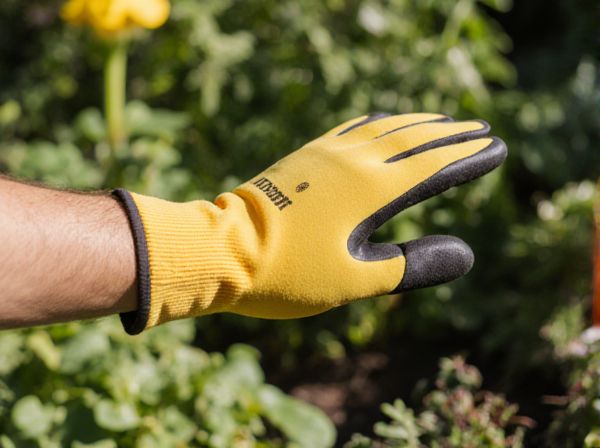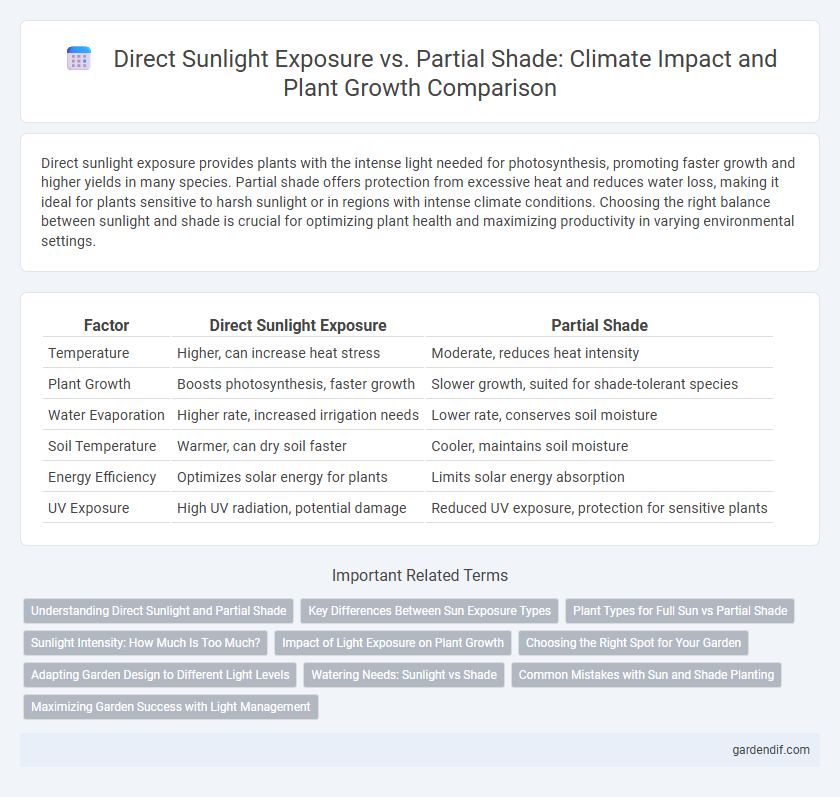
Direct Sunlight Exposure vs Partial Shade Illustration
Direct sunlight exposure provides plants with the intense light needed for photosynthesis, promoting faster growth and higher yields in many species. Partial shade offers protection from excessive heat and reduces water loss, making it ideal for plants sensitive to harsh sunlight or in regions with intense climate conditions. Choosing the right balance between sunlight and shade is crucial for optimizing plant health and maximizing productivity in varying environmental settings.
Table of Comparison
| Factor | Direct Sunlight Exposure | Partial Shade |
|---|---|---|
| Temperature | Higher, can increase heat stress | Moderate, reduces heat intensity |
| Plant Growth | Boosts photosynthesis, faster growth | Slower growth, suited for shade-tolerant species |
| Water Evaporation | Higher rate, increased irrigation needs | Lower rate, conserves soil moisture |
| Soil Temperature | Warmer, can dry soil faster | Cooler, maintains soil moisture |
| Energy Efficiency | Optimizes solar energy for plants | Limits solar energy absorption |
| UV Exposure | High UV radiation, potential damage | Reduced UV exposure, protection for sensitive plants |
Understanding Direct Sunlight and Partial Shade
Direct sunlight exposure delivers intense, unfiltered solar radiation that significantly affects plant growth, temperature regulation, and moisture evaporation rates. Partial shade provides intermittent sun access, reducing heat stress and water loss, which benefits shade-tolerant species or environments with harsh midday sun. Understanding the balance between direct sunlight and partial shade is essential for optimizing plant health, soil moisture retention, and microclimate conditions in diverse ecosystems.
Key Differences Between Sun Exposure Types
Direct sunlight exposure delivers intense ultraviolet (UV) radiation and higher temperatures, influencing photosynthesis rates and water evaporation in plants more significantly than partial shade. Partial shade offers variable light intensity, reducing heat stress and slowing moisture loss, which benefits shade-tolerant species and human skin protection from UV damage. The key differences between these sun exposure types lie in their effects on microclimate, plant growth patterns, and UV radiation intensity.
Plant Types for Full Sun vs Partial Shade
Full sun plants like tomatoes, lavender, and sunflowers thrive with at least six hours of direct sunlight daily, promoting vigorous growth and abundant flowering. Partial shade plants such as hostas, ferns, and impatiens prefer 3 to 6 hours of filtered sunlight or dappled shade, minimizing leaf scorch and moisture loss. Selecting appropriate plant types based on sunlight exposure optimizes photosynthesis efficiency and overall garden health.
Sunlight Intensity: How Much Is Too Much?
Direct sunlight exposure delivers intense UV radiation that can cause heat stress and damage to both plants and skin if prolonged beyond two hours daily. Partial shade reduces sunlight intensity by approximately 50%, offering protection against excessive UV exposure while still supporting photosynthesis and vitamin D synthesis. Optimal sunlight intensity varies by species and skin type, with the threshold for damage often occurring at UV index levels above 6.
Impact of Light Exposure on Plant Growth
Direct sunlight exposure significantly enhances photosynthesis by providing plants with the maximum light intensity required for robust growth and higher biomass production. Partial shade limits light intensity, which can reduce photosynthetic rates but may help prevent heat stress and water loss in sensitive plant species. Optimizing light exposure based on plant type improves growth efficiency, nutrient uptake, and overall health in varying climatic conditions.
Choosing the Right Spot for Your Garden
Selecting the ideal location for your garden depends on the specific sunlight requirements of your plants; full direct sunlight, typically 6-8 hours daily, supports the growth of sun-loving species like tomatoes and peppers. Partial shade areas, receiving 3-6 hours of sunlight or filtered light, benefit shade-tolerant plants such as lettuce and leafy greens, helping to prevent heat stress and dehydration. Understanding the microclimate and sunlight patterns in your garden ensures optimal plant health, maximizing photosynthesis and crop yield.
Adapting Garden Design to Different Light Levels
Designing gardens to accommodate varying light levels enhances plant health and growth by selecting species suited for direct sunlight exposure or partial shade. Sun-loving plants like tomatoes and lavender thrive under full sun, whereas ferns and hostas perform better in shaded conditions, reducing water stress and leaf scorch. Incorporating shade structures, reflective surfaces, and strategic plant placement optimizes light distribution, promoting biodiversity and energy efficiency in garden ecosystems.
Watering Needs: Sunlight vs Shade
Plants exposed to direct sunlight typically require more frequent watering due to increased evaporation rates and faster soil drying. In contrast, plants in partial shade retain soil moisture longer, resulting in reduced watering needs. Understanding the balance between sunlight exposure and watering frequency is essential for optimal plant health and efficient water use.
Common Mistakes with Sun and Shade Planting
Common mistakes in sun and shade planting include placing shade-loving plants in areas with direct sunlight exposure, leading to leaf scorch and stunted growth, or situating sun-loving plants in partial shade, resulting in poor flowering and leggy growth. Understanding the specific light requirements of species like hostas or hydrangeas helps prevent stress caused by overexposure or insufficient light. Proper assessment of microclimates and sun patterns ensures optimal plant health and reduces the risk of climate-related damage.
Maximizing Garden Success with Light Management
Maximizing garden success hinges on understanding the balance between direct sunlight exposure and partial shade, as many plants require at least 6 hours of direct sunlight for optimal photosynthesis and growth. Partial shade reduces water evaporation and protects delicate foliage from heat stress, ultimately improving plant resilience in warmer climates. Effective light management includes assessing plant species' sunlight tolerance and positioning them strategically to enhance growth, conserve moisture, and prevent sunburn in intense light conditions.
Direct Sunlight Exposure vs Partial Shade Infographic

 gardendif.com
gardendif.com